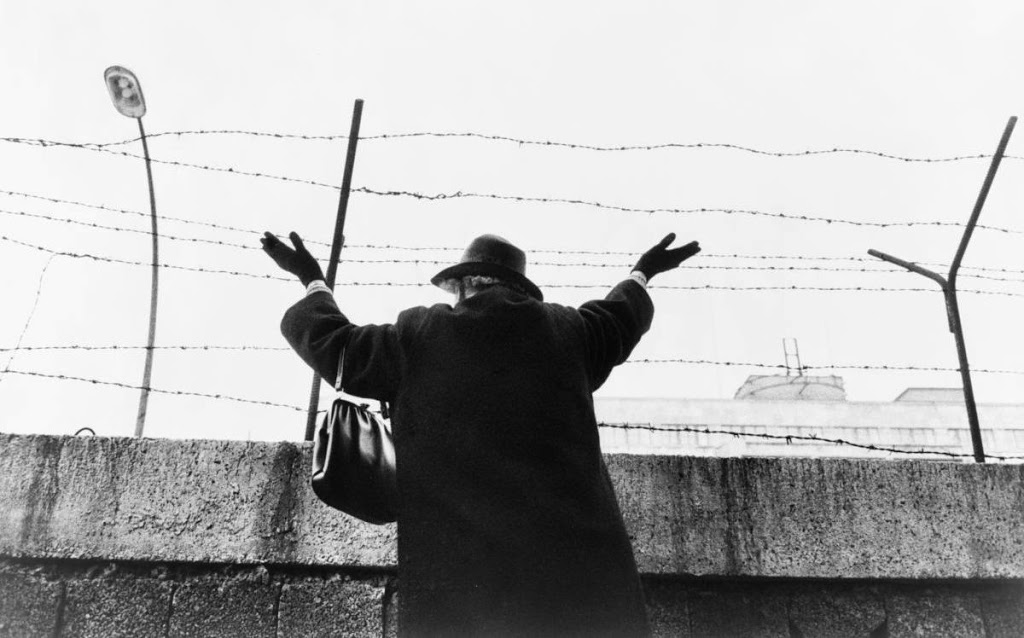
Waving over the Berlin Wall, photo: Dan Budnik (1933-2020), Public domain, via Wikimedia Commons
You might wonder, why we have a German headline today. But, this is an original quote, and also a very famous one about the Berlin Wall… On June 15, 1961, first Secretary of the Socialist Unity Party and German Democratic Republic State Council chairman Walter Ulbricht stated in an international press conference,
“Niemand hat die Absicht, eine Mauer zu errichten!” (No one has the intention of erecting a wall!)
Of course you know that they did erect a wall in the middle of Berlin, which divided the German capital for almost 30 years.
Post WW2
After the end of World War II in Europe, what remained of pre-war Germany west of the Oder-Neisse line was divided into four occupation zones, each one controlled by one of the four occupying Allied powers. In the same way the capital of Berlin was subdivided into four sectors despite the city’s location fully within the Soviet zone. Within two years, political divisions increased between the Soviets and the other occupying powers. These included the Soviets‘ refusal to agree to reconstruction plans making post-war Germany self-sufficient and to a detailed accounting of the industrial plants, goods and infrastructure already removed by the Soviets. Britain, France, the United States and the Benelux countries later met to combine the non-Soviet zones of the country into one zone for reconstruction and to approve the extension of the Marshall Plan.
Berlin Blockade
In 1948, following disagreements regarding reconstruction and a new German currency, Soviet leader Joseph Stalin instituted the Berlin Blockade, preventing food, materials and supplies from arriving in West Berlin. The former Western allies began a massive “airlift“, supplying West Berlin with food and other supplies until in May 1949, Stalin lifted the blockade, permitting the resumption of Western shipments to Berlin. On 7 October 1949, the German Democratic Republic (East Germany) was declared. East Germany differed from the Western counterpart, the Federal Republic of Germany, which developed into a Western capitalist country with a social market economy and a democratic parliamentary government. Continual economic growth starting in the 1950s fuelled a 20-year “economic miracle” (“Wirtschaftswunder“) and as West Germany’s economy grew, and its standard of living steadily improved, many East Germans wanted to move to West Germany. In the first 6 months of 1953 alone, more than 226,000 had already fled.
Consequently, the inner German border between the two German states was closed, and a barbed-wire fence erected. The border between the Western and Eastern sectors of Berlin, however, remained open, although traffic between the Soviet and the Western sectors was somewhat restricted. This resulted in Berlin becoming a magnet for East Germans desperate to escape, and also a flashpoint for tension between the United States and the Soviet Union. In 1957, East Germany introduced a new passport law that reduced the overall number of refugees leaving Eastern Germany with the result of drastically increasing the percentage of those leaving through West Berlin from 60% to well over 90% by the end of 1958. Despite heavy penalties, but with no physical barrier and subway train access still available to West Berlin, such measures were ineffective. The emigrants tended to be young and well-educated, leading to the “brain drain” feared by officials in East Germany. An important reason that the West Berlin border was not closed earlier was that doing so would cut off much of the railway traffic in East Germany. With the construction of a new railway bypassing West Berlin, the Berlin outer ring, completed in 1961, closing the border became a more practical position. In particular the brain drain of professionals had become so damaging to the political credibility and economic viability of East Germany that the re-securing of the German communist frontier was imperative.
Building a Wall
Thus, on 15 June 1961, First Secretary of the Socialist Unity Party and GDR State Council chairman Walter Ulbricht stated in an international press conference, “Niemand hat die Absicht, eine Mauer zu errichten!“. It was the first time the colloquial term Mauer (wall) had been used in this context. The record of a telephone call between Nikita Khrushchev and Ulbricht on 1 August in the same year, suggests that it was from Khrushchev that the initiative for the construction of the wall came. What is beyond dispute, though, is that Ulbricht had pushed for a border closure for quite some time, arguing that East Germany’s very existence was at stake. Khrushchev had been emboldened by US President John F. Kennedy’s tacit indication that the US would not actively oppose this action in the Soviet sector of Berlin.
On Saturday, 12 August 1961, while attending a garden party, Ulbricht signed the order to close the border and erect a wall. At midnight, the police and units of the East German army began to close the border and, by Sunday morning, 13 August, the border with West Berlin was closed. East German troops and workers had begun to tear up streets running alongside the border to make them impassable to most vehicles and to install barbed wire entanglements and fences along the 156km around the three western sectors, as well as the 43km that divided West and East Berlin.
The Fall of the Berlin Wall | Axel Martens | Talks at Google, [5]
References and Further Reading:
- [1] The Berlin Wall Memorial
- [2] The Berlin Wall at berlin.de
- [3] The Bridge of Spies and the biggest Agent Swap in History, SciHi Blog
- [4] The Berlin Wall at Wikidata
- [5] The Fall of the Berlin Wall | Axel Martens | Talks at Google, 2014, Talks at Google
- [6] Image Grid from pictures related to the Berlin Wall, via DBpedia and Wikidata





